

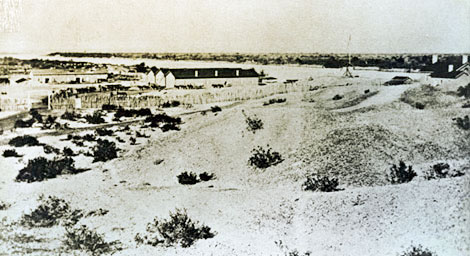 In 1864, the U.S. Army established the Yuma Quartermaster Depot on the Arizona side of the Colorado River where a six-month supply of goods was kept at all times. This is the earliest and one of few photographs of the depot taken before 1871. (Reclamation photograph)
In 1864, the U.S. Army established the Yuma Quartermaster Depot on the Arizona side of the Colorado River where a six-month supply of goods was kept at all times. This is the earliest and one of few photographs of the depot taken before 1871. (Reclamation photograph)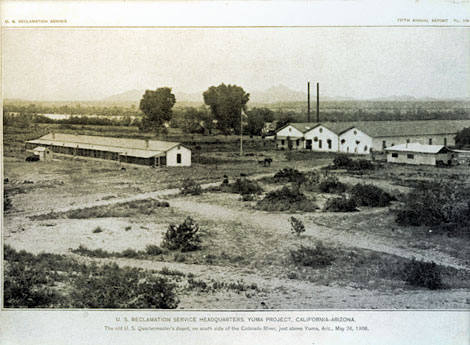 U.S. Reclamation Service headquarters, Yuma Project, located at the former Fort Yuma U.S. Army Quartermaster Depot and Yuma Crossing. (Yuma Projects Office Fifth Annual Report, May 26, 1906)
U.S. Reclamation Service headquarters, Yuma Project, located at the former Fort Yuma U.S. Army Quartermaster Depot and Yuma Crossing. (Yuma Projects Office Fifth Annual Report, May 26, 1906)By 1870, Yuma was Arizona Territory's second largest settlement, an important trade center and crossing point on the Colorado River. The area was home to the Quechan Indians who, for centuries, had been farming along the river using simple irrigation practices. Yuma became a favored point to ford the Colorado River, and with the discovery of gold in California in 1848, it served as an important military post and supply center. Yuma continued to grow during the latter half of the nineteenth century, but irrigation farming was limited until the late 1890s because of lawsuits over a Spanish Land Grant known as the "Algodones" grant (http://www.amerisurv.com/content/view/5942/136/) that tied up land on the east side of the river. In 1898 with the settlement of the lawsuit, homesteading and farming grew rapidly as did development of private irrigation companies.
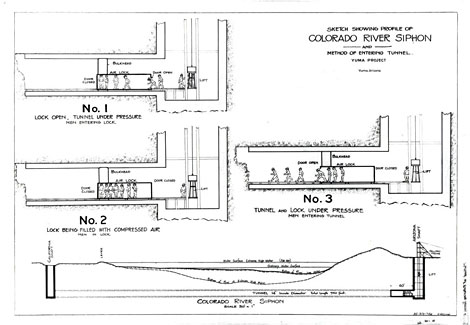 Sketch of the Colorado River Siphon. (National Archives, Yuma Projects Office, No date)
Sketch of the Colorado River Siphon. (National Archives, Yuma Projects Office, No date)The silt-laden Colorado presented problems for farmers because silt quickly blocked canal head gates restricting water flow into the canal and ditches. This problem, along with flooding and the active meandering of the river within the floodplain, created problems for Reclamation Service engineers who began investigating the irrigation potential along the river in 1902. By early 1903, they had identified a dam site at Laguna on the Arizona side of the river, and preliminary locations for the other major features including canals, levees, and a drainage system. The Yuma Project was authorized on May 10, 1904 and was one of the earliest irrigation projects for the new Reclamation Service.
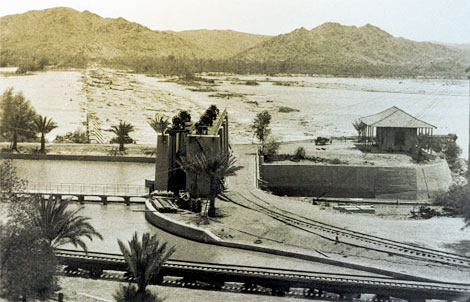 View of Laguna Dam showing the desilting basin, sluice gates, and Yuma Canal regulating gates. (National Archives, Yuma Projects Office, No date)
View of Laguna Dam showing the desilting basin, sluice gates, and Yuma Canal regulating gates. (National Archives, Yuma Projects Office, No date)Construction of Laguna Dam began in July 1905 and was completed in March 1909. That same year, construction of the California Main Canal, the system's largest, began. It began at the western end of the dam and headed south on the California side to point opposite the town of Yuma. Here it crossed under the river in a siphon to the town of Yuma, where it split into the East and West Main Canals to provide water to farmers in the fertile Yuma Valley. Other canals were constructed off the eastern end of Laguna Dam to farm lands along the Gila River. These irrigation systems allowed Yuma to develop into a major agricultural center.
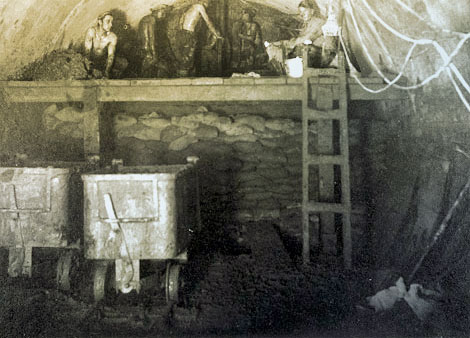 Sand hogs at work on the heading of the Colorado River Siphon tunnel underneath the Colorado River. A "sand hog" is a slang term for construction workers who work underground on a variety of construction projects. A bulkhead of sandbags was built at the end lower of the tunnel while excavation continue in the upper half of the tunnel. The sandbags prevented water from seeping in on the sand hogs while the arch was being drilled, 1912. (National Archives, Yuma Project Office)
Sand hogs at work on the heading of the Colorado River Siphon tunnel underneath the Colorado River. A "sand hog" is a slang term for construction workers who work underground on a variety of construction projects. A bulkhead of sandbags was built at the end lower of the tunnel while excavation continue in the upper half of the tunnel. The sandbags prevented water from seeping in on the sand hogs while the arch was being drilled, 1912. (National Archives, Yuma Project Office)
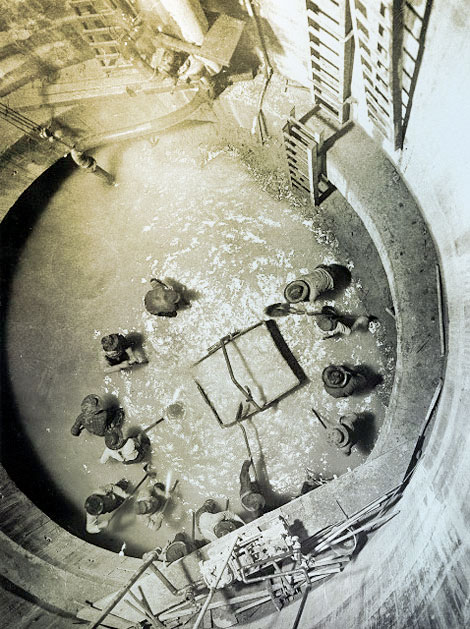 Colorado River Siphon. Looking down 55 feet into the Arizona shaft during the night shift, 1910. (National Archives, Yuma Projects Office)
Colorado River Siphon. Looking down 55 feet into the Arizona shaft during the night shift, 1910. (National Archives, Yuma Projects Office)Adapted from The Historic Yuma Project, History, Resources Overview, and Assessment by Christine Pfaff, Rolla L. Queen, and David Clark. Bureau of Reclamation, Cultural Resources Program. Denver, 1992, Revised 1999.
